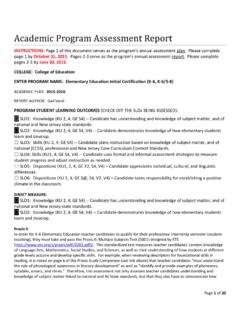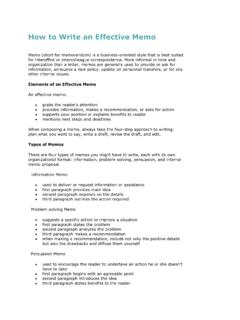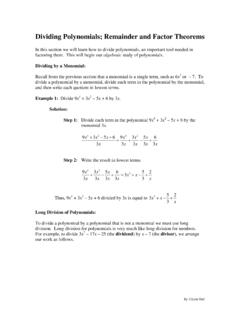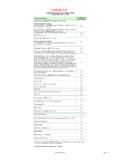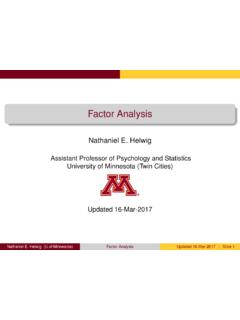Transcription of 1.3 Division of Polynomials; Remainder and Factor …
1 1-32 CHAPTER 1. POLYNOMIAL AND RATIONAL Division of polynomials ; Remainder and FactorTheoremsObjectives Perform long Division of polynomials Perform synthetic Division of polynomials Apply Remainder and Factor theoremsIn previous courses, you may have learned how to Factor polynomials using varioustechniques. Many of these techniques apply only to special kinds of polynomialexpressions. For example, the the previous two sections of this chapter dealt onlywith polynomials that could easily be factored to find the zeros order to be able to find zeros andx-intercepts of polynomials which cannotreadily be factored, we first introduce long Division of polynomials . We will thenuse the long Division algorithm to make a general statement about factors of Division of polynomialsLong Division of polynomials is similar to long Division of numbers.
2 When divid-ing polynomials , we obtain a quotient and a Remainder . Just as with numbers, if aremainder is0, then the divisor is a Factor of the 1 Determining factors by DivisionDivide to determine whetherx 1is a Factor ofx2 3x+ 3x+2is thedividendandx 1is 1 Set up the Division as follows:divisor x 1)x2 3x+2 dividendStep 2 Divide the leading term of the dividend (x2) by the leading term of the divisor(x). The result (x)is the first term of the quotient, as illustrated first term of quotientx 1)x2 3x+ Division OF polynomials ; Remainder AND Factor THEOREMS1-33 Step 3 Take the term of the quotient that was just found (x), and multiply it by thedivisor, which givesx2 this result in the second 1)x2 3x+2x2 x multiplyxby divisorStep 4 Subtract the second row from the first row (which gives 2x), and treat theresulting expression ( 2x+2) as though it were a new dividend, just like inlong Division of 1)x2 3x+2x2 x 2x+2 (x2 3x+2) (x2 x)(watch your signs!
3 Step 5 Continue as in Steps 1-4, but in Step 2 divide the leading term of the expres-sion in the bottom row ( , the leading term of 2x+2) by the leading termof the divisor. This result ( 2) is the second term of the 2x 1)x2 3x+2x2 xleading term is 2x 2x+2multiply 2by divisor 2x+2( 2x+2) ( 2x+2)=0 0 Thus dividingx2 3x+2byx 1givesx 2as thequotientand0as theremainder, which means that the (x 1) is a Factor of the (x2 3x+2).Check your answer:(x 2)(x 1) =x2 3x+2. 1-34 CHAPTER 1. POLYNOMIAL AND RATIONAL FUNCTIONSC heck It Out 1 Find the quotient and Remainder when the polynomialx2+x 6is divided byx 2. We can make the following statement about the relationship between the dividend,divisor, quotient and Remainder :(divisor quotient) + Remainder = is a very important result and is stated formally as Division AlgorithmLetp(x)be a polynomial divided by a nonzero polynomiald(x).
4 Then, there are aquotient polynomialq(x)and a Remainder polynomialr(x)such thatp(x)=d(x)q(x)+r(x),or equivalently,p(x)d(x)=q(x)+r(x)d(x),wher e eitherr(x)=0or the degree ofr(x)is less than the degree ofd(x).The following illustrates the relationship between factors and and remaindersLet a polynomialp(x)be divided by a nonzero polynomiald(x), with aquotientpolynomialq(x)and aremainder polynomialr(x).Ifr(x)=0, thend(x)andq(x)are bothfactorsofp(x).The next example will show how polynomial Division can be used to Factor a poly-nomial that cannot be factored by straightforward methods that you may 2 Long Division of PolynomialsFind the quotient and Remainder when2x4+7x3+4x2 7x 6is divided by2x+ Division OF polynomials ; Remainder AND Factor THEOREMS1-35 SolutionWe follow the same steps as before, but shall condense them in 1 Divide the leading term of the dividend (2x4) by the leading term ofthe divisor (2x).
5 The result,x3, is the first term of the quotient. Multiply the term of the quotient that was just found,x3, by the divisor,and put the result,2x4+3x3, in the second row. Subtract the second row from the first row, just like in the Division +3)2x4+7x3+4x2 7x 62x4+3x3 multiplyx3by divisor4x3+4x2 7x 6 subtractionStep 2 Divide the leading term of the expression in the bottom row,4x3, by theleading term of the divisor. Multiply the result,2x2, by the divisor, andsubtract:x3+2x22x+3)2x4+7x3+4x2 7x 62x4+3x34x3+4x2 7x 64x3+6x2 multiply2x2by divisor 2x2 7x 6 subtractionStep 3 Divide the leading term of the expression in the bottom row, 2x2, by theleading term of the divisor. Multiply the result, x, by the divisor, andsubtract:x3+2x2 x2x+3)2x4+7x3+4x2 7x 62x4+3x34x3+4x2 7x 64x3+6x2 2x2 7x 6 2x2 3x multiply xby divisor 4x 6 subtraction (be careful with signs!
6 1-36 CHAPTER 1. POLYNOMIAL AND RATIONAL FUNCTIONSStep 4 Divide the leading term of the expression in the bottom row, 4x, by theleading term of the divisor. Multiply the result, 2, by the divisor, andsubtract:x3+2x2 x 22x+3)2x4+7x3+4x2 7x 62x4+3x34x3+4x2 7x 64x3+6x2 2x2 7x 6 2x2 3x 4x 6 4x 6 multiply 2by divisor0 subtraction (be careful with signs!)Thus dividing2x4+7x3+4x2 7x 6by2x+3gives a quotient,q(x),ofx3+2x2 x 2with a Remainder ,r(x),of0, or equivalently,2x4+7x3+4x2 7x 62x+3=x3+2x2 x can check that(2x+3)(x3+2x2 x 2) = 2x4+7x3+4x2 7x 6. Check It Out 2 Find the quotient and Remainder when6x3 x2 3x+1is divided by2x 1. Thus far, all the long Division problems illustrated have not produced a next example will give an illustration of long Division with a 3 Long Division with RemainderFind the quotient and Remainder whenp(x)=6x3+x 1is divided byd(x)=x+2.
7 Write your answer in the formp(x)d(x)=q(x)+r(x)d(x). Division OF polynomials ; Remainder AND Factor THEOREMS1-37 SolutionThe steps for long Division should now be pretty clear to you. Note that the expression6x3+x 1does not have anx2term; , itscoefficient is0. Thus, when we set up the Division , we write thex2term as0x2. We then divide6x3by the leading term of the divisor:6x2x+2)6x3+0x2+x 16x3+12x2 multiply6x2by divisor 12x2+x 1 subtraction Next, we divide 12x2by the leading term of the divisor:6x2 12xx+2)6x3+0x2+x 16x3+12x2 12x2+x 1 12x2 24x multiply 12xby divisor25x 1 subtraction Finally, we divide25xby the leading term of the divisor:6x2 12x+25x+2)6x3+0x2+x 16x3+12x2 12x2+x 1 12x2 24x25x 125x+50 multiply25by divisor 51 subtractionThus, the quotientq(x)=6x2 12x+25and the Remainder ,r(x),is 51,orequivalently,6x3+x 1x+2=6x2 12x+25 51x+ this example, long Division yields a nonzero Remainder .
8 Thusx+2isnotafactor of6x3+x 1. 1-38 CHAPTER 1. POLYNOMIAL AND RATIONAL FUNCTIONSC heck It Out 3 Find the quotient and Remainder when3x3+x2 1is divided byx+1. Writeyour answer in the formp(x)d(x)=q(x)+r(x)d(x). Synthetic divisionSynthetic Division is a compact way of dividing polynomials when the divisor isof the formx c. Instead of writing out all the terms of the polynomial, we workonly with the coefficients. We illustrate this shorthand form of polynomial divisionwith the problem from Example 4 Synthetic DivisionUse synthetic Division to divide6x3+x 1byx+ the divisor is of the formx c, we can use synthetic thatc= 1 Write down the coefficients of the dividend in a row, from left to right, andthen place the value ofc(which is 2) in that same row, to the left of theleading coefficient of the dividend:value ofc= 2 2|601 1 list coefficients of the dividendStep 2 Bring down the leading coefficient of the dividend,6, and then multiply it byc, which is 2: 2|601 1 12 b) then multiply6by 2a) first bring down6 6 Step 3 Place the result, 12, below the coefficient of the next term of the dividend,0, and add: 2|601 1 126 12 add0and Division OF polynomials .
9 Remainder AND Factor THEOREMS1-39 Step 4 Apply Steps 2(b) and 3 to the result, which is 12: 2|601 1 1224 multiply 12byc6 12 25 add1and24 Step 5 Apply Steps 2b and 3 to the result, which is25: 2|60 1 1 12 24 50 multiply25byc= 26 1225 51 add 1and 50 Step 6 Read off the coefficients of the quotient from the bottom row:q(x)=6x2 12x+25 The Remainder ,r(x),is 51, the last number in the bottom row. The result isthe same as the one found by long Division , but the procedure is much morecompact. Check It Out 4 Use synthetic Division to divide 2x3+3x2 1byx 1. The Remainder and Factor theoremsWe now examine an important connection between a polynomialp(x)and theremainder we get whenp(x)is divided byx c. In Example 3 , Division ofp(x)=6x3+x 1byx+2yielded a Remainder of 51.
10 Also,p( 2) = this just a coincidence? Not really it s actually one of the many interestingproperties of polynomial Division . The Remainder theorem is formally stated Remainder TheoremWhen a polynomialp(x)is divided byx c, the Remainder is equal to the value ofp(c).Since the Remainder is equal top(c), synthetic Division provides a quick way toevaluatep(c). This is illustrated in the next 1. POLYNOMIAL AND RATIONAL FUNCTIONSE xample 5 Applying the Remainder TheoremLetp(x)= 2x4+6x3+3x 1. Use synthetic Division to evaluatep(2).SolutionFrom the Remainder theorem,p(2)is the Remainder obtained whenp(x)is divided byx 2. Following the steps outlined in Example 4, we have | 2603 1 44 8 22 2241121 Since the Remainder is21, we know thatp(2) = 21. Check It Out 5 Letp(x)=3x4 x2+3x 1.

